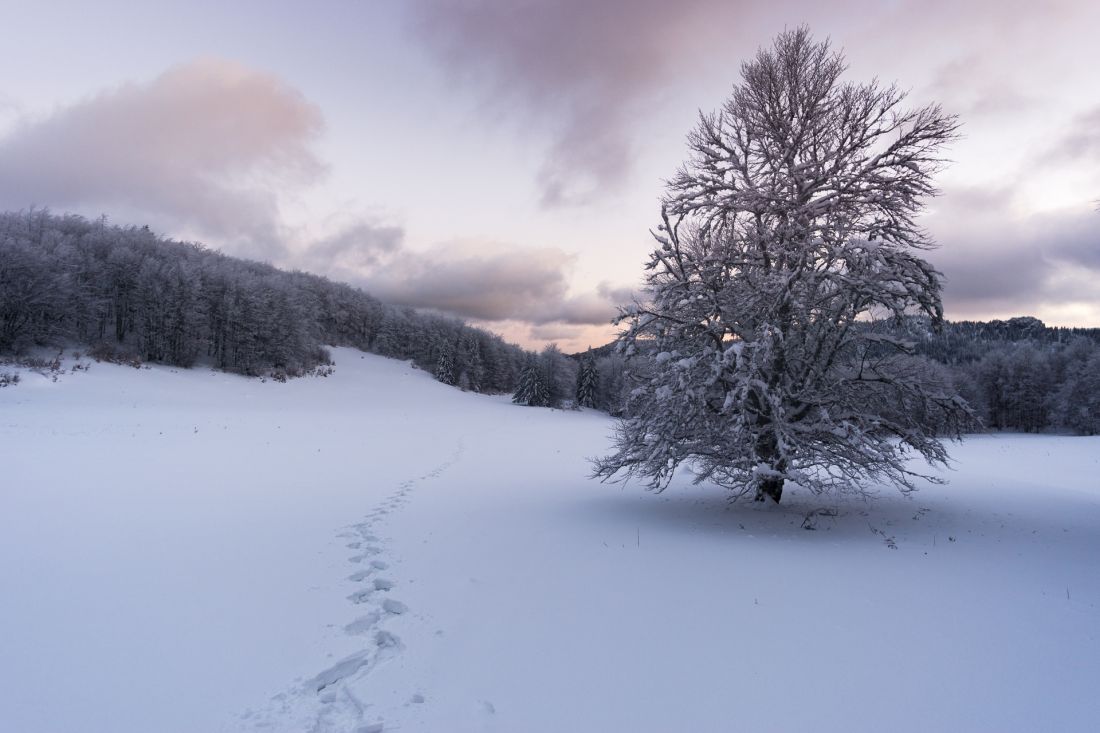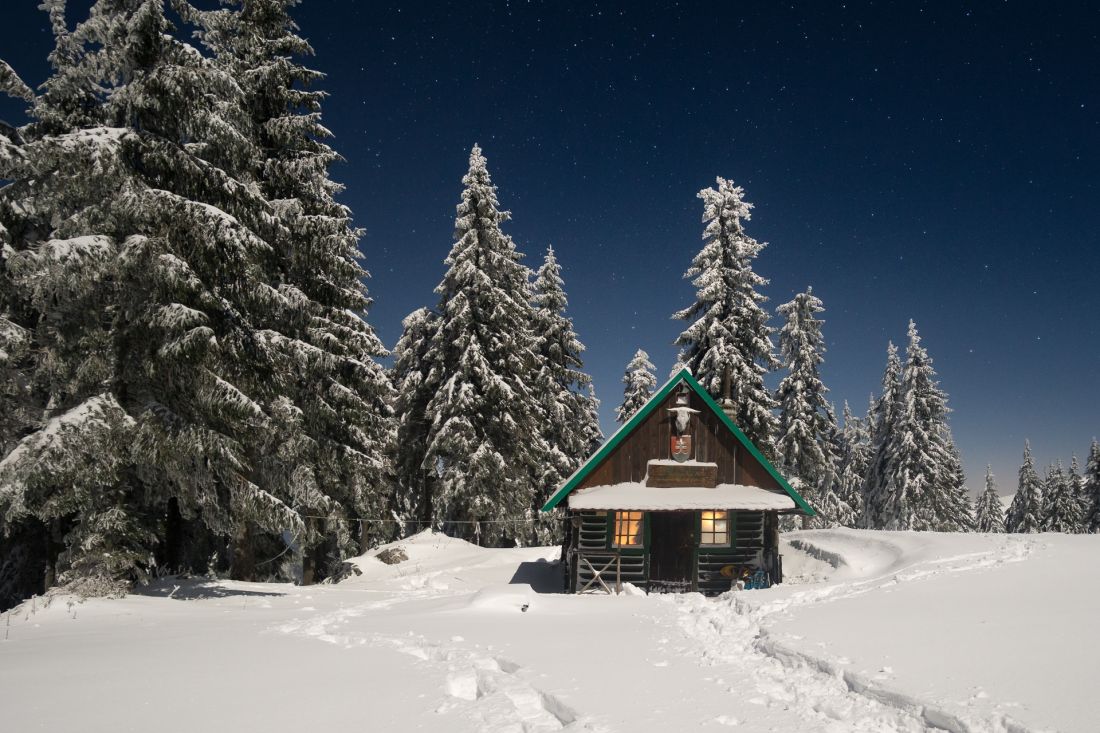It is snowing but the path is easy in the beginning. Before the first ascent I put on the snowshoes and suddenly it becomes harder. Halfway up I already curse myself and swear I will never come out with such a bad idea ever again. If I did not arrive so late (missed bus), I would be enjoying wonderful sunset higher up with nice views by now. Clouds seem just so perfect. Tomorrow it will be clear skies according to forecasters. Sucks. But it is nothing yet until I reach the treeline. Huge plain leading to the ridge awaits me with trail completely lost under snow, all footsteps cleared by wind. At least one meter of pulver snow lies there. Even with snowshoes, the legs sink deep. I decide to use a direct shortcut to the ridge as no trail markers are to be seen anyway. The sun is already gone as I advance too slowly and temperature falls quickly deep below freezing point. Full moon rises behind my back so at least I do not have to put on my headlamp. In my mind, the moon must be laughing at my slow progress.
When I arrive to the ridge, I am really looking forward to the comfort of nearby self-service wooden cabin. I hope somebody is already there heating up the stove. However, as the moon shines bright, I can scout the surroundings now and spare a few minutes in the morning. I am looking for interesting shapes in snow, sastrugi, or anything that could work well in a photo. I expect I would have to ascent nearby Suchý Vrch but large part of a meadow next to the ridge trail is nicely rugged and below it stands prominent tree. I immediatelly know what I want to capture here. So that is it for now, I head for the cabin.
It is long before sunrise when I am back on the location looking for the best composition. I know what I want to capture from yesterday: view towards rounded mountain Ploská, High Tatras, Low Tatras and the sun rising behind. That one prominent tree I mentioned earlier really catches my eye. Unlike other trees, this one shines white covered in snow and really pops out against darker hills behind it. It simply stands out so I want to adapt composition to suit it. Only thing that remains to decide is foreground of the image which I want to fill only with snow shapes. Problem is that once I decide to go down the slope, my footsteps completely destroy all the shapes in the snow cover and I can not return to the first composition. So I advance slowly until I find composition I really like.

First composition test (raw export): simple rule of thirds, prominent tree in upper right intersection point. Snow forms a "triangle" leading into the image center both from left and right. Also imaginary line leads all the way from lower right corner continuing with the slope below the forest. However, the shapes in snow seem too subtle to me with many distracting points.

Second composition test (raw export): simple rule of thirds, tree again in upper right intersection point. Oval shapes stand out more and lead to the center of image. Two of those in intersection points. However, the area behind it is too harsh, I do not like it as it breaks the image in two halves. Moreover, too much empty space in the lower right corner which I can not easily eliminate (the tree would get too much to the center of the image which I wanted to avoid at all costs). Later during viewing the i
I decide to go further destroying compositions I tried until now. There are huge flat shapes just below (visible in both test compositions). If I want to make the image clean, I have to get really close, like half a meter or so. My wide angle lens may be wide but not that wide to capture it whole with all the mountains behind. That means I have to get more images to stitch them together later. I make a few test shots to check it. Yes, the place seems good now (but composition remains only in my head as I can not see the final image anymore - it will consist of a number of partial images) so I wait for the sunrise.
Sun rises moments later filling landscape with soft orange-pinkish light. Checking exposimeter it seems it would be better to "play it safe" and use bracketing to preserve highlights.

Bracketing of one partial image: overexposed (+2EV), flat exposed and underexposed (-2EV) images combined into the bracketed image. Technique known as HDR - but used softly without overdoing it. Main aim here was to get smoother color transitions in snow and to preserve highlights (notice the sun disc in combined image). If I omitted this step, I would have had only the middle normal exposed image out of these as a starting point for editing which would result in overally flatter image. This may not seem so
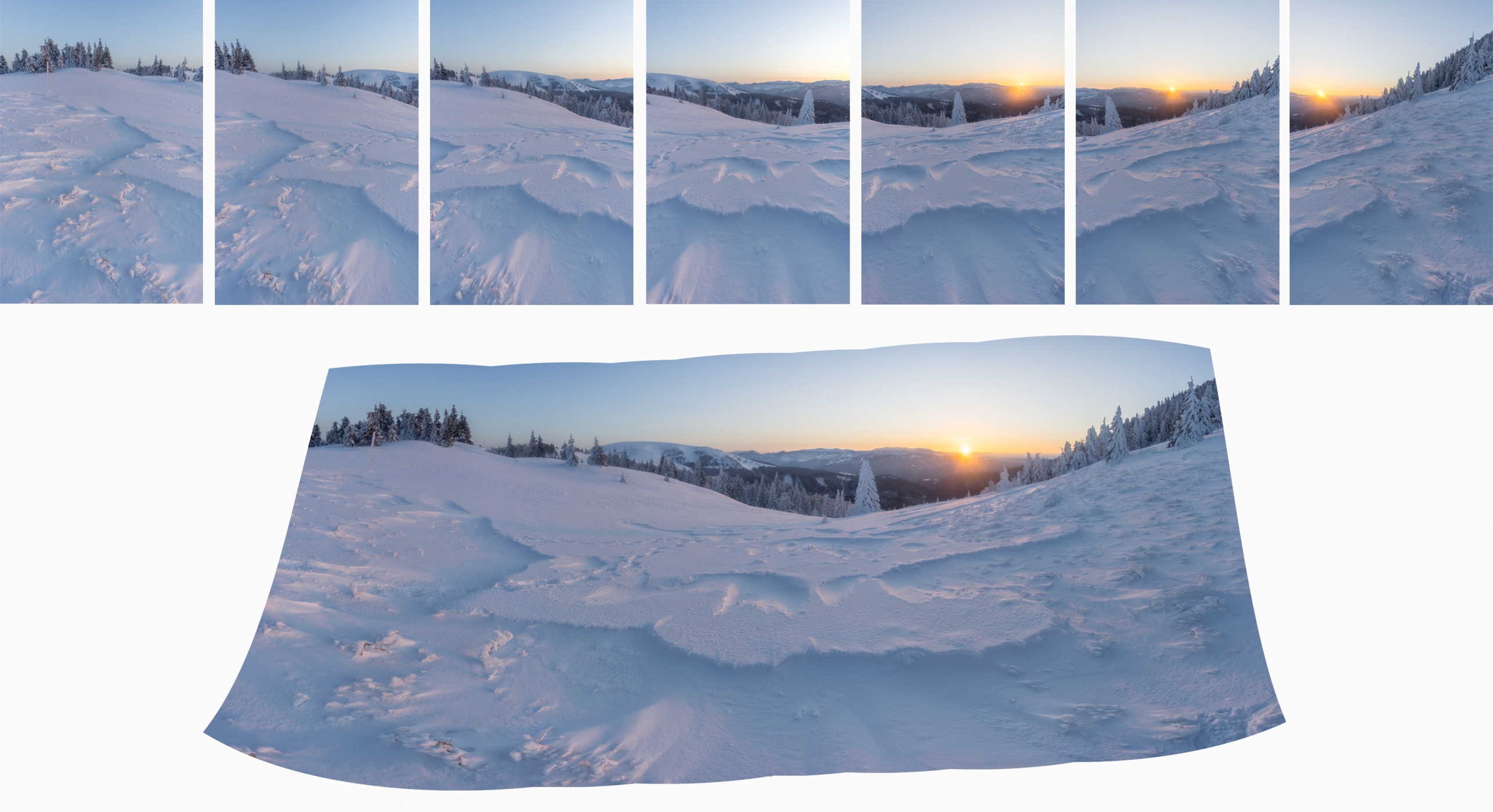
Stitching partial images into one: having 7 images in one row, 3 images for bracketing per each, it means I had to shoot 3x7=21 total. Notice the difference in curvature of partial images caused by the wide angle lens (e.g. the tree leans to the left or to the right according to its position in frame even though all shots were captured with horizon straight). It is better to use not so wide lens for panoramic stitched images due to this effect. Luckily, algorithms these days present usable results anyway an
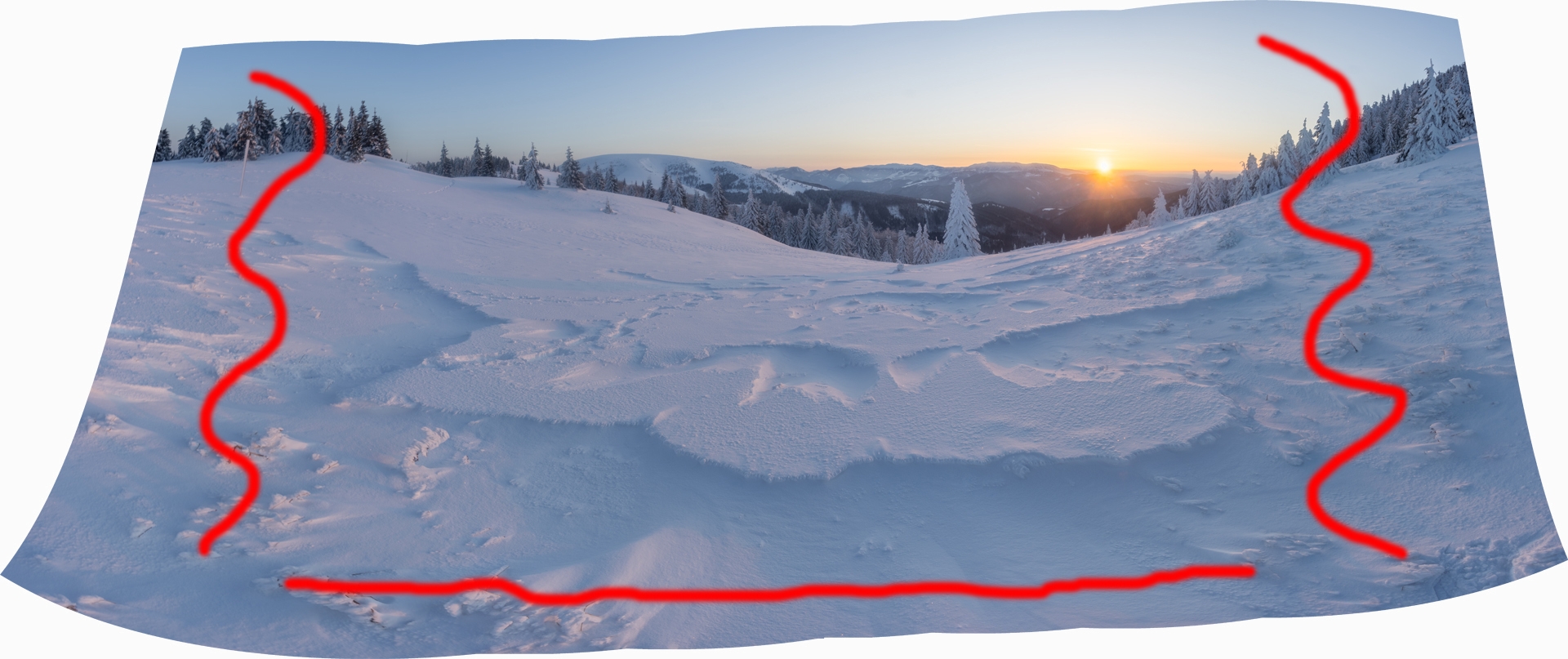
The field of view of captured scene is enormous, in this case the image spans approximately 180°. But there is a lot of "waste" as I call parts of the image that have to be cut out. It is always desirable to shoot this waste, however. You can only make the final image out of pixels you have (content creation nasty magic put aside) and easily crop it if needed. Here I did not like empty sides that add nothing interesting to the image (there is even trail marking pole in upper left corner) and also the bottom
Now, the obtained image is still a "digital negative" containing all the sensor information and has to be further developed. I remembered the snow frosty bright and the sun somewhat more orange to red which I wanted to get into my image as well. My camera tends to get oranges more to the yellow side which I correct often. Also, the tricky part here is not to make the snow too much blue by increasing contrast too much. It seems nice during editing but the result is unrealistic.
Major adjustment was done to make the scene feel warmer (as it was in reality) without getting tones in snow too warm. Microcontrast was increased in the area of snow to make icy crystals distinguishable. Whole foreground area was also dodged and burned to increase contrast between parts in shadow and parts catching direct sunlight. I wanted to make these as bright as possible without losing detail as sunlit snow feels blinding even in the morning.
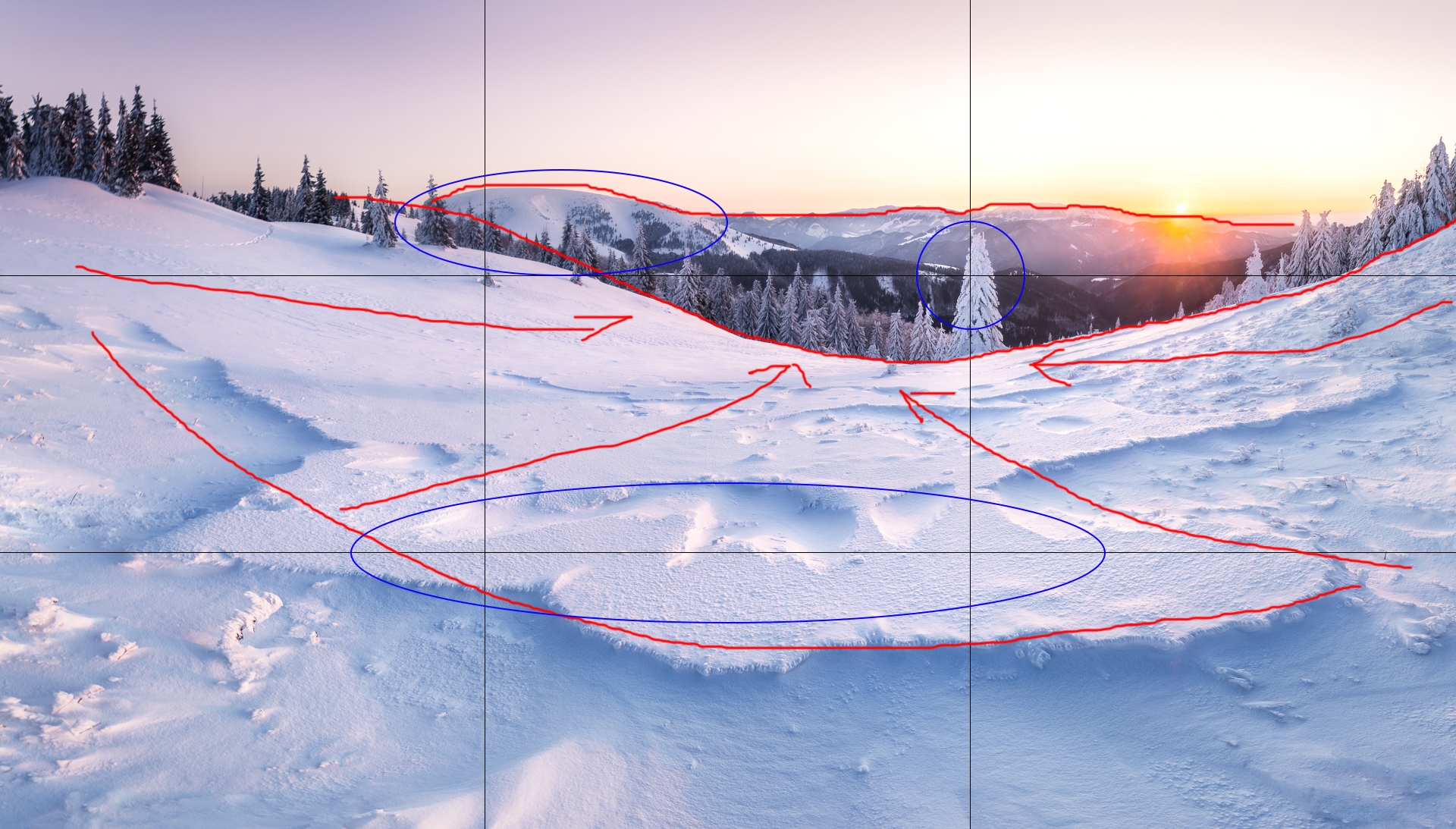
Final image composition: it still uses simple rule of thirds with white tree in upper right intersection point. It also nicely balances mountain Ploská in upper left intersection point. Foreground makes the interesting part here as the main shape in snow copies the curve of lower horizon (ending below forest). From this shape that forms the foreground, viewer's eye is naturally dragged towards middle ground and to the white tree. Finally, background plan is fomed by Tatra mountains and the sun rising behind
